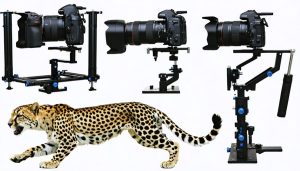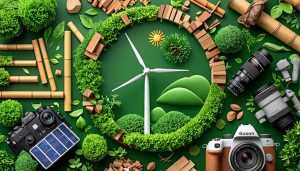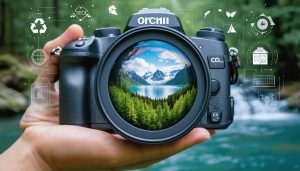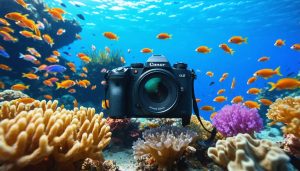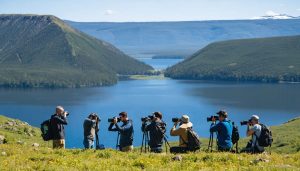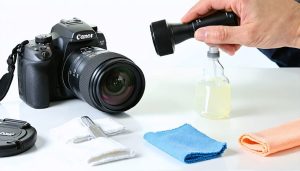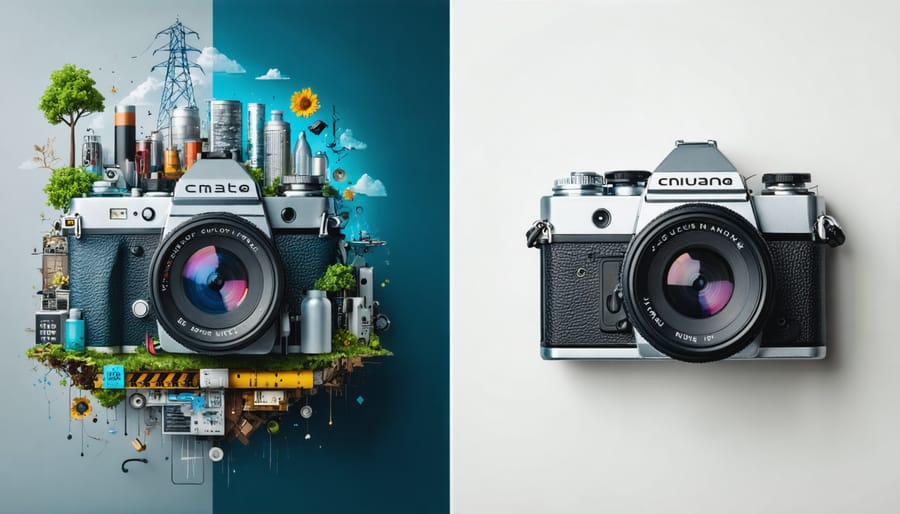
Transform your photography practice into an environmentally conscious art form by switching to rechargeable batteries, extending your gear’s lifespan through proper maintenance, and choosing eco-friendly printing labs. The environmental impact of photography extends far beyond just equipment choices – from digital storage solutions to packaging materials, every decision shapes our footprint. Professional photographers worldwide are discovering that sustainable practices not only protect our planet but also create compelling market differentiation and reduce operational costs. By embracing digital delivery methods, investing in durable equipment, and minimizing chemical processing, photographers can maintain exceptional image quality while significantly reducing waste and energy consumption. The shift toward sustainability in photography isn’t just a trend – it’s a fundamental reimagining of how we capture, process, and share images in harmony with our environment.
The Environmental Impact of Photography Equipment
Digital vs. Film: The Environmental Perspective
The debate between digital and film photography takes on new significance when viewed through an environmental lens. While film photography involves chemical processing and physical materials, digital photography’s environmental impact stems primarily from electronic waste and energy consumption.
Film photography requires chemical developers, fixers, and paper, all of which can introduce toxic substances into water systems if not properly disposed of. Additionally, the production and disposal of film canisters contribute to plastic waste. However, the slower, more deliberate nature of film photography often means photographers take fewer shots, potentially reducing overall resource consumption.
Digital photography, while eliminating chemical waste, brings its own environmental challenges. The manufacturing of cameras, memory cards, and backup drives requires significant resources and energy. The constant upgrade cycle of digital equipment contributes to growing e-waste concerns. However, digital cameras offer the advantage of unlimited shots without additional material consumption, and modern storage solutions reduce the need for physical printing.
The most sustainable approach often combines the best of both worlds: using digital equipment for longer periods while being mindful of energy consumption and proper e-waste disposal.
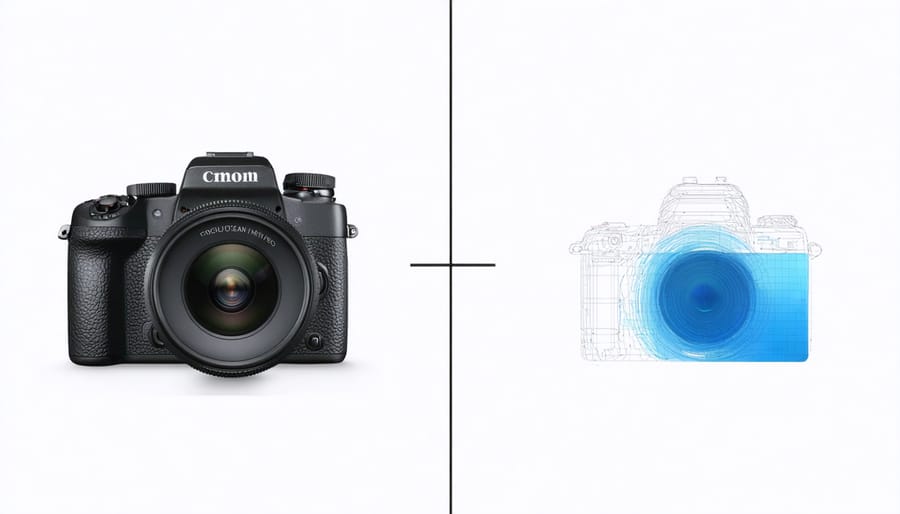
The True Cost of Gear Consumption
Photography gear has a significant environmental footprint that extends far beyond the moment of purchase. Each camera, lens, and accessory begins its journey with raw material extraction, often involving mining for precious metals and rare earth elements. The manufacturing process consumes substantial energy and resources, while transportation across global supply chains adds to the carbon footprint.
What’s particularly concerning is the rapid pace of gear turnover in our industry. The average lifespan of a digital camera is just 3-5 years, not because of mechanical failure, but due to the constant push for upgraded features. When equipment is discarded, it often ends up in landfills where toxic materials like lithium batteries and electronic components can leach into the environment.
Consider this: a single professional DSLR camera requires roughly the same amount of resources to manufacture as 20 smartphones. By extending the life of our existing gear through proper maintenance and repairs, we can significantly reduce our environmental impact. Before rushing to upgrade, ask yourself if new equipment will truly enhance your creative vision or if you’re simply caught in the cycle of consumption.
Practical Steps for Sustainable Photography
Equipment Choices and Maintenance
Choosing and maintaining photography equipment sustainably isn’t just about buying the latest eco-friendly gear – it’s about making smart choices that stand the test of time. When selecting equipment for professional quality photography, opt for durable, high-quality items that won’t need frequent replacement.
Consider buying secondhand equipment from reputable dealers. Many professional cameras and lenses maintain their quality for years when properly cared for, and purchasing used gear reduces manufacturing demand while saving you money. Look for weather-sealed bodies and lenses that can withstand various shooting conditions.
Regular maintenance is crucial for extending equipment life. Develop a routine cleaning schedule: clean lenses with appropriate solutions, store gear in dry environments with silica gel packets, and use proper cases for protection. Keep firmware updated and have professional servicing done when needed rather than replacing equipment prematurely.
Instead of accumulating multiple similar lenses, invest in versatile pieces that serve multiple purposes. A high-quality 24-70mm lens, for instance, can cover various shooting scenarios while reducing your gear footprint. When upgrading is necessary, sell or donate your old equipment to ensure it continues its useful life with another photographer.
Remember to properly dispose of batteries and electronic waste through certified recycling programs, and choose rechargeable options whenever possible.
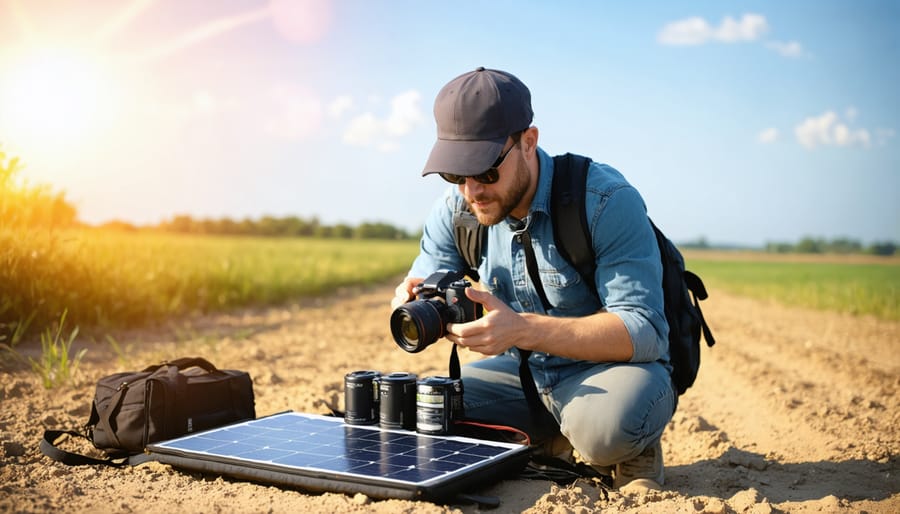
Energy-Efficient Shooting Practices
Reducing power consumption during photo shoots isn’t just good for the environment – it’s also practical for your workflow and equipment longevity. Start by fully charging all batteries before a shoot to minimize the need for mid-session charging. Consider investing in high-capacity batteries that last longer and require fewer replacements over time.
When shooting indoors, maximize natural light whenever possible. Position your subject near windows or use reflectors to bounce existing light rather than relying heavily on artificial lighting setups. If artificial lighting is necessary, opt for LED panels over traditional hot lights – they consume significantly less power and generate minimal heat.
For location shoots, plan your shooting schedule around optimal natural lighting conditions. Golden hour provides not only beautiful light but also reduces the need for supplementary lighting. Consider energy-efficient mobile photography solutions when appropriate, as smartphones and tablets generally consume less power than traditional cameras for certain types of shoots.
Power management features on your camera can make a significant difference. Disable unnecessary functions like image review and wireless connectivity when not needed. Use sleep mode settings effectively, and turn off the camera between setups rather than letting it idle. For longer shoots, bring spare batteries instead of relying on charging stations, which can be energy-intensive.
Remember to properly maintain your equipment – clean sensors and lenses require less power to operate effectively, and well-maintained batteries hold their charge longer.
Responsible Post-Processing
The digital darkroom can be just as environmentally impactful as shooting in the field, but there are several ways to make your post-processing workflow more sustainable. Start by optimizing your computer’s power settings and using energy-efficient equipment. Consider switching to a laptop instead of a desktop computer, as laptops typically consume less power.
Cloud storage, while convenient, requires significant energy to maintain data centers. Implement a smart archiving strategy by regularly reviewing and deleting unnecessary files. Store your most important images on energy-efficient external hard drives, and consider using solid-state drives (SSDs) which consume less power than traditional hard disk drives.
When editing, work in batches to minimize computer runtime. Use presets and templates for common adjustments to speed up your workflow. If you’re working with multiple images from the same shoot, apply basic corrections to all files simultaneously rather than processing each one individually.
Consider the environmental impact of your output choices. When printing is necessary, opt for eco-friendly papers and inks. For digital delivery, compress your files appropriately – this not only reduces storage requirements but also minimizes the energy needed for file transfer and storage on servers.
Remember to properly dispose of or recycle any electronic equipment when upgrading. Many manufacturers and retailers offer recycling programs for old devices and storage media.
Green Field Practices
Leave No Trace Photography
When photographing in natural environments, following Leave No Trace principles is crucial for preserving the beauty we aim to capture. Start by staying on designated trails and viewing areas to prevent soil erosion and protect delicate vegetation. If you must venture off-trail for that perfect shot, carefully choose your path and avoid stepping on plants or disturbing wildlife habitats.
Always maintain a respectful distance from wildlife – a good telephoto lens is your best friend here. Avoid using flash photography around animals, as it can disturb their natural behavior and stress them unnecessarily. Remember that getting the perfect shot isn’t worth compromising an animal’s wellbeing.
Pack out everything you bring in, including memory cards, lens caps, and any equipment packaging. Consider carrying a small bag specifically for collecting any trash you find along the way. When shooting during golden hour or blue hour, bring adequate lighting to safely navigate your way back without disturbing the environment.
For landscape photography, resist the urge to move natural elements for composition. Instead, challenge yourself to work with nature as you find it. If you’re shooting with props or additional lighting equipment, ensure everything is secured and won’t blow away or damage the surroundings.
Finally, share your location information responsibly. While it’s natural to want to share beautiful spots, consider whether fragile locations might be better protected by keeping them private or sharing only general area information.
Wildlife Photography Ethics
Photographing wildlife requires a delicate balance between capturing stunning images and respecting the natural world. Following wildlife photography best practices is essential for both the well-being of animals and the integrity of your work.
Always maintain a safe distance from wildlife, using appropriate telephoto lenses rather than disturbing animals for a closer shot. Remember, no photograph is worth causing stress or altering natural behavior. Avoid using calls, bait, or artificial lighting that might disrupt feeding patterns or attract predators.
Learn to read animal behavior and recognize signs of distress. If an animal changes its behavior due to your presence, you’re too close. This is particularly crucial during breeding seasons and around nesting sites.
Stay on designated paths and avoid trampling vegetation, as this helps preserve both the habitat and the creatures that depend on it. Consider joining local wildlife photography groups that emphasize ethical practices and share knowledge about animal behavior and habitats.
Document truthfully and avoid staging shots. Natural behavior tells more compelling stories than manufactured moments. Share your images responsibly by including accurate context and avoiding locations of sensitive species that might attract unnecessary traffic.
Remember that as photographers, we’re guests in these animals’ homes. Our primary role is to document and celebrate wildlife while contributing to its conservation through responsible practices.
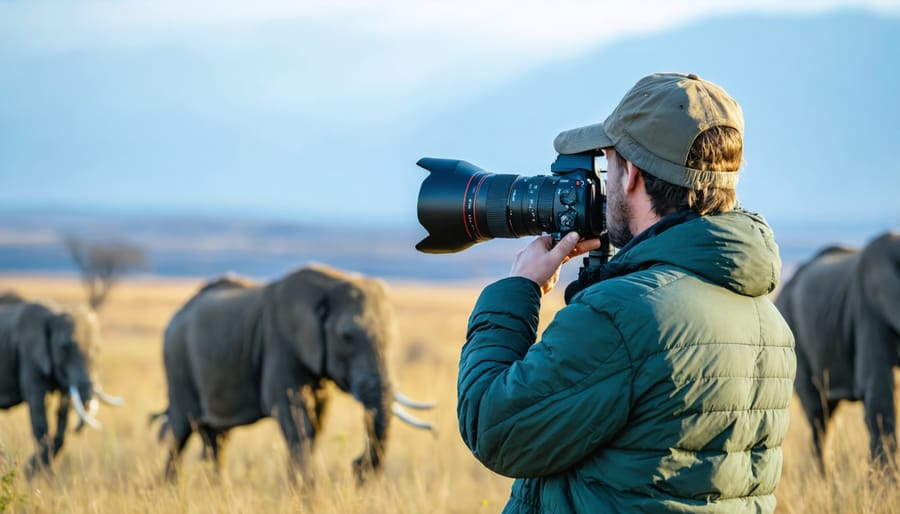
Future-Proofing Your Photography Practice
As we look toward the future of photography, sustainability isn’t just a trend – it’s becoming a fundamental aspect of how we practice our craft. The photography industry is rapidly evolving, and staying ahead means adapting to both technological advances and environmental considerations.
One of the most promising developments is the rise of computational photography. As cameras become more sophisticated, they’re able to achieve better results with less equipment, reducing the need for multiple lenses and accessories. This not only lightens your gear bag but also decreases the environmental impact of manufacturing and transporting equipment.
Cloud-based workflows are becoming increasingly efficient, allowing photographers to reduce their reliance on physical storage devices and minimize electronic waste. Many services now offer carbon-neutral storage solutions, powered by renewable energy, making digital asset management more sustainable than ever.
The future of sustainable photography also lies in emerging technologies like biodegradable camera components and eco-friendly printing materials. Several manufacturers are already experimenting with recycled and plant-based materials for camera bodies and accessories. Keep an eye on these developments, as they’re likely to become industry standards in the coming years.
To future-proof your practice, consider investing in modular equipment that can be upgraded rather than replaced entirely. This approach not only saves money in the long run but also significantly reduces waste. Look for manufacturers who offer repair programs and have strong environmental commitments.
Education and community building will play crucial roles in sustainable photography’s future. Consider joining or creating local photographer groups focused on sustainability, sharing resources, and collaborating on eco-friendly projects. These connections can help you stay informed about new sustainable practices and technologies while building a network of like-minded professionals.
Remember that future-proofing isn’t just about equipment – it’s about adapting your business model too. Consider offering digital-first packages, implementing virtual consultations, and exploring ways to reduce travel impact through careful scheduling and local focus.
As we’ve explored throughout this article, sustainable photography isn’t just a trend – it’s a necessary evolution of our craft that benefits both our planet and our work. By embracing eco-friendly practices, from choosing energy-efficient equipment to adopting digital workflows, we can significantly reduce our environmental footprint while maintaining professional standards.
Remember, every small change matters. Whether it’s switching to rechargeable batteries, properly disposing of chemicals, or opting for sustainable printing materials, these choices add up to create meaningful impact. The future of photography doesn’t have to come at the expense of our environment.
As you move forward with your photography journey, consider implementing at least one sustainable practice from this guide each month. Start with what feels most manageable – perhaps digitizing your workflow or investing in longer-lasting equipment. Share your sustainable photography practices with fellow photographers and clients alike, helping to spread awareness and encourage others to follow suit.
The photography industry has always been about capturing and preserving moments. Now, it’s time we extend that preservation mindset to our planet. By making conscious choices in our photography practice, we’re not just creating beautiful images – we’re contributing to a more sustainable future for our art form and our world.
Let’s commit to being part of the solution. After all, the most compelling images are those that can be created without compromising the very landscapes and environments we love to photograph.

